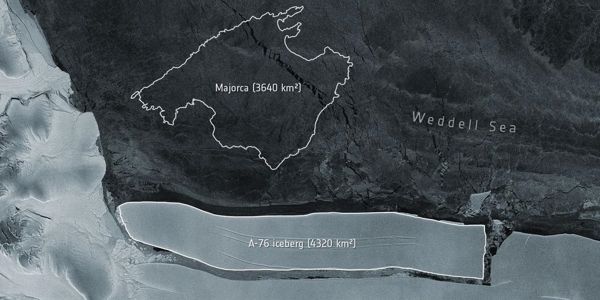According to The European Space Agency, a massive iceberg roughly 70 times the size of Manhattan has broken off from Antarctica, becoming the world’s largest iceberg (ESA). The massive ice slab, 1,668 square miles in size, is now floating in the Weddell Sea, south-east of South America, and was spotted by the ESA’s Copernicus Sentinel-1, land, and sea monitoring satellite constellation — an epic demonstration of the dynamism of the living planet.
It is the latest in a series of large ice blocks to dislodge in a region vulnerable to climate change, though scientists say it appears to be part of a natural polar cycle in this case. According to the US National Ice Center, A-76, which is slightly larger than the Spanish island of Majorca, has been monitored by scientists since May 13, when it began to separate from the Ronne Ice Shelf.
A huge ice block has broken off from western Antarctica into the Weddell Sea, becoming the largest iceberg in the world and earning the name A-76.
Berg Rush
According to Ted Scambos, a research glaciologist at the University of Colorado at Boulder, the event is not related to climate change and is instead part of a natural cycle. According to Scambos, because the iceberg was already in the water, its formation will not raise ocean levels.
Other scientists concur. “It is not an area that is changing significantly as a result of global warming,” confirmed Alex Brisbourne, a glaciologist at the British Antarctic Survey, to the New Scientist. “The main point is that it is part of a natural cycle.”
While the breakup was not directly related to climate change, some experts believe there are more concerning changes at work. “I am concerned about any ice loss today because any ice loss is part of our larger global ice loss, and it is terrifying to me,” glaciologist and National Geographic Society explorer M Jackson told The New York Times. “We have a glacier problem globally; we are losing a lot of ice.”

The iceberg, dubbed A-76, broke away from the Ronne Ice Shelf, one of Antarctica’s largest ice sheets. According to the New Scientist, the shelf has previously seen several massive bergs break off over the last few decades, with the largest break up occurring in 1986.
According to the European Space Agency, the iceberg first broke off from the western edge of the Ronne Ice Shelf, which is located in Antarctica’s Weddell Sea (ESA). According to USNIC, it is 89 nautical miles long and 14 nautical miles wide, with a total area of 1,668 square miles. In comparison, it is larger than both the Spanish island of Mallorca (1,405 square miles) and the state of Rhode Island (1,034 square miles). According to HuffPost, it is also nearly six times larger than New York City.
According to the ESA, the iceberg is the largest in the world. It dwarfs the 3,880 square kilometers A-23A iceberg, which is also floating in the Weddell Sea (approximately 1,498 square miles). The previous record-holder, known as A-68a, appeared to be on a collision course with the tiny island of South Georgia, but thankfully broke up before it impacted local wildlife.
While the shearing off of large chunks of ice shelves is a natural cycle, some shelves have experienced a rapid break up in recent years as a result of global warming. The Antarctic ice sheet is warming faster than the rest of the planet, causing snow and ice covers to melt, particularly near the Weddell Sea.
Another large Antarctic iceberg that threatened a penguin-populated island in South America has since lost much of its mass and broken up. According to a study published earlier this month in the journal Nature, average sea levels have risen about nine inches since 1880, with ice melting in the Greenland and Antarctic ice sheets accounting for roughly a quarter of that rise.
The study, conducted by 84 scientists from 15 countries, concluded that the recently set more ambitious national goals to slow climate change are insufficient to prevent sea levels from rising.
















